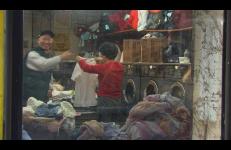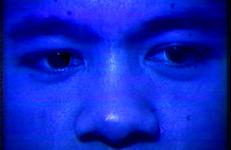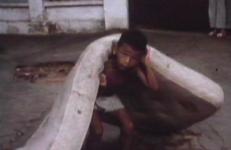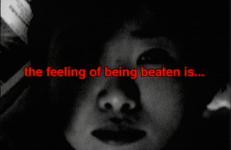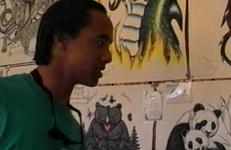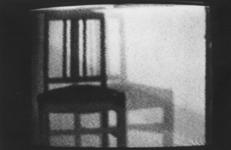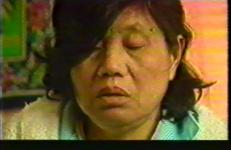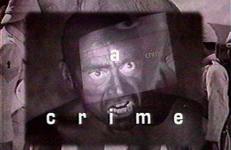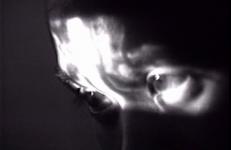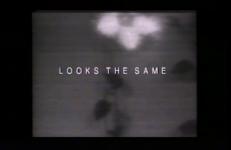37 Stories About Leaving Home provides a rare and personal view into the lives of Japanese women. This beautifully constructed and complex video weaves stories told by a group of Japanese grandmothers, mothers and daughters, ranging in age from 15 to 83. The stories recount each woman’s personal journey from child to adulthood—their experiences of leaving home.
Asian-American
You live somewhere, walk down the same street 50, 100, 10,000 times, each time taking in fragments, but never fully registering THE PLACE. Years, decades go by and you continue, unseeing, possibly unseen. A building comes down, and before the next one is up you ask yourself "what used to be there?" You are only vaguely aware of the district's shifting patterns and the sense that, since the 19th Century, wave after wave of inhabitants have moved through and transformed these alleyways, tenements, stoops and shops.
A huge isolated rock in the midst of the desert in Australia: Ayers Rock. I produced two contrasting films around this rock: Moments at the Rock was shot with an amateur video camera, amazing color changes, and time-lapsed compressed sequences; A Rock in the Light, edited with the music of Haruyuki Suzuki, is more visually structured, following the passing of time from the sunrise to the sunset.
--Takahiko iimura
"Takahiko iimura's Air's Rock is an ultimate landscape film."
--Katsuhiro Yamagucki, artist and author
"Combining the comical with the absurd, I created six funny faces to animate the images of Japanese vowels while differentiating between 'image', 'letter', and 'voice'."
— Takahiko iimura
"iimura deconstructs our coherence as he shifts between the English roman alphabet and Japanese characters, interjects spoken Japanese, and manipulates the computer images of his features. The images often take on geometrical shapes, others recall the classical images from Japanese woodcuts of Samurai warrior grimace."
— Robert West, Curator, Mint Museum of Art, Charlotte, NC
The introductory title to The Blindness Series, aletheia presents an indexing of categories investigating different aspects of blindness as metaphor. Stylistic preference for the techniques and conventions of MTV, and American Television in general, provides the means to create connections among the categories of cosmetic surgery, sexuality, technology, language, hysterical blindness, and actual blindness.
This title is also available on Tran, T. Kim Trang: The Blindness Series.
Snapshots of individuals from all parts of Asia and the Pacific Islands form a stream of images that blankly proves the fallacy of the title phrase. Soe challenges viewers to recognize the failure of vision that underlies this common misperception, and the failure of understanding that creates and propagates such generalizations.
Spanish subtitled version available.
amaurosis is an experimental documentary about Dat Nguyen, a blind guitarist living in Little Saigon, Orange County, California. Dat Nguyen was a "triple outcast": blind, Amerasian, and an impoverished orphan. His American father left Viet Nam in 1973, and his mother died in 1975. Living on the streets of Saigon, he sold lottery tickets for food money. At the age of 12, Dat met a classical music teacher who was also blind and who taught him to read Braille as well as supported him.
Another Clapping explores the relationship triangle between a daughter, her mother and the Chinese Cultural Revolution. It is an experimental documentary based on the mother's violent past with its traumatic political history and an unsuccessful marriage. Through their subsequent experiences as immigrants in Canada and the complex process of remembering and reviewing the past, history comes to signify the characteristic of the individual. The tracing of memory illuminates the difficulties of identifying mother and daughter as different people.
Asian Studs Nightmare examines the racial politics behind the hit U.S. television show STUDS. Fulbeck frantically recalls somewhat fictional nightmares of Asian male identity. Over a multi-layered visual of the actual STUDS show and Asian male stereotypes, Asian Studs reveals the pervasive racial hierarchies and taboos depicted in mass media and probes their relation to interracial dating patterns and minority status in the United States.
Kip Fulbeck's landmark video, Banana Split, defined the genre of multiracial exploration in contemporary video, and established him as one of the premiere artists exploring Hapa and multracial identity. Completed while Fulbeck was still in graduate school, Banana Split screened throughout the U.S. and abroad, and is still used in hundreds of classes today.
Quoting Confucius, that “food and sex are human nature,” Chinese Characters builds a parallel between the Chinese legend about the search for the source of the Yellow River and contemporary Asian-Canadian gay men’s search for pleasure via their relationship to gay pornography. Advancing the positive value of pornography as a way to help fantasize and experience greater sexual pleasure and ingenuity, personal techniques are demonstrated and deployed in a High Noon dream of sexual adventure.
Color Schemes was exhibited in its installation form (with a self-service washing machine) at the Whitney Museum in 1990. Using the washing machine as a metaphor for the great American “melting pot” of ethnicity, the video presents individuals from a variety of ethnic backgrounds “representing” their ethnicity — in one sense by being on camera, and also by acting out or speaking about ethnic divisions. Cheang plays with this “overdetermiNation” of ethnicity, creating a multi-layered discourse on racism and assimilation that condemns the former and refuses to condone the latter.
This humorous video begins with two women—one white, the other Asian—attempting to fit into a Japanese bathtub. The awkward fitting of bodies into a small space is just one of the allegorical scenarios dramatized in a pressing appeal for lesbian rights. In a game of hanafuda (flower cards), the terms of lesbian domesticity are cleverly played out according to such legalities as joint property, social security, and pensions.
Script/Performance Izumo Marou and Claire Maree, Superdyke Inc. Japan.
Song by Chu.
The title implies a relationship between the two persons in the frame of the image. The woman in the foreground appears somewhat sad, the man in the background concerned. In the slowed-down motion of the video, these expressions become intensified, and heightened to levels of romantic tragedy by the accompaniment of Chet Baker’s melancholy song, 'You Don’t Know What Love Is'. As we become more involved in this narration, the slightest shift of her head or the subtlest movement of his eyes become important players in this relation....
This title is only available on Kip Fulbeck Selected Videos: Volume One.
Dear features the interior world of two teenage Chinese girls in New York City, whose diary entries reveal their concerns related to growing up as immigrants amidst the ever-gentrifying landscape of Chinatown.
Performers: Anna Yu, Shu Xia Zhao
Cinematography: Steve Cossman
Voice: Joanna Lin, Shu Xia Zhao
Music: Ikue Mori
Production: Xiao Li Tan
A collection of early conceptually oriented videos which were produced in Tokyo in the early 1970s using words along with images, except for the first two flicker-effect pieces: A Chair (1970) and Blinking (1970).
Time Tunnel (1971) is an attempt at time travel in a very conceptual sense.
Man and Woman (1971) shows full body images of a naked man and woman shot from above without movement. They are shown alone as well as together, one over (or under) the other, symbolizing words at the same time as their positions.
In 1992, Tran came across a New York Times article about a group of hysterically blind Cambodian women in Long Beach, California, known as the largest group of such people in the world. Hysterical blindness is sight loss brought about by traumatic stress, and has little or no physical causes. ekleipsis delves into two histories: the history of hysteria and the Cambodian civil war.
Epilogue: The Palpable Invisibility of Life is the final chapter in The Blindness Series, a body of eight videos on blindness and its metaphors that was begun in 1992. The inspiration for the series came from a 1990 exhibition Jacques Derrida curated for the Louvre Museum, titled Memoirs of the Blind.
Using footage from the legendary Bruce Lee’s last, unfinished, film, Fulbeck turns the subtitled martial arts movie on itself—levelling criticism and commentary with the genre's own tools, and examining the various representative functions of the late actor.
A search for a non-existent image, a desire to create an image where there is none,“ leads to Rea Tajiri’s composition on recorded history and non-recorded memory. Framed by the haunting facts of the post-Pearl Harbor Japanese internment camps (which dislocated 120,000 Japanese Americans during World War II), Tajiri creates a version of her family’s story through interviews and historical detail, remembering a time that many people would rather forget.
Using footage from mainstream British and Hollywood films, and excerpts from a poem by Shani Mootoo, this video explores the impact of cultural imperialism and the erasure of language—residual tools of oppression on members of post-colonial societies.
This title is also available on The New McLennium.
By focusing on the blindfold, kore explores the eye as purveyor of desire, sexual fear, and the fantasy of blindness. An alternative sexuality is founded in touch-based (feminine?) pleasure as opposed to a vision-based (masculine?) pleasure. An examination of institutional blindspots towards women, and people of color, concerning AIDS expands on the issue of vision, visibility and the disease.
This title is also available on Tran, T. Kim-Trang: The Blindness Series.
This title is only available on Kip Fulbeck Selected Videos: Volume Two.
Lighthouse is about the labor system and the factory town in Southern China and how individualism is influenced by the social and political infrastructure. Guangdong District is the largest Metropolitan area in one of China's wealthiest provinces, and one of its cities, Guangzhou, attracts farmers from the countryside looking for factory work. The viewer is led to actively compose narratives through the poetic and the sublime images. It opens borders that separate cultural, linguistic and historical differences in the global labor systems.





